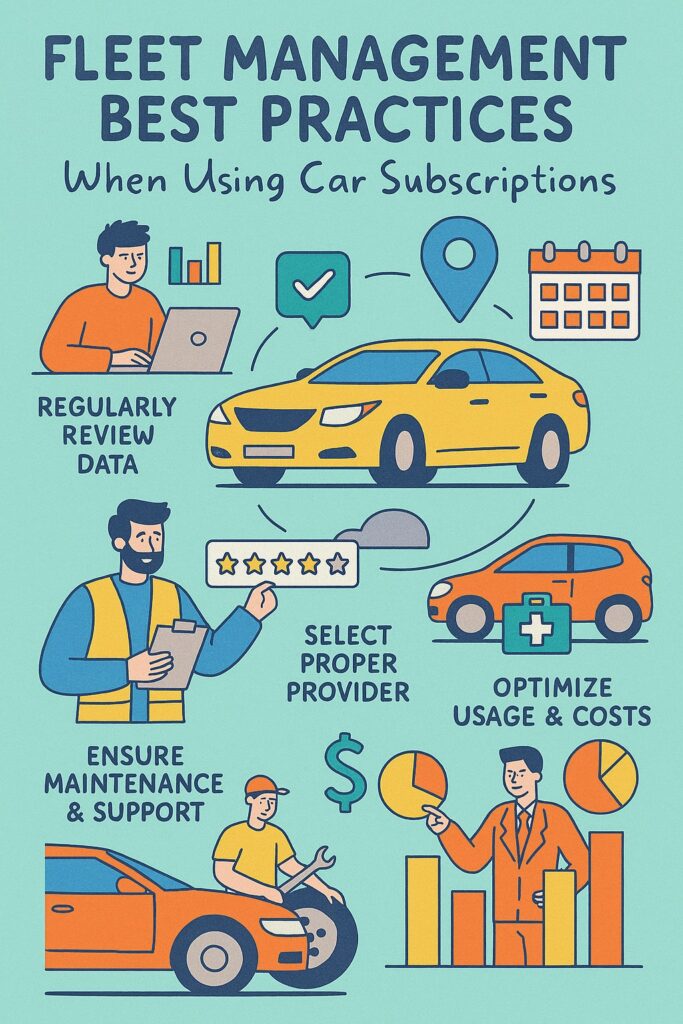Car subscriptions are transforming the way businesses manage their fleets. Instead of being tied down to long-term leases or outright purchases, companies can now enjoy the flexibility of subscription-based vehicles. This model allows businesses to scale up or down quickly, access newer models, and reduce the administrative burden of ownership.
But with flexibility comes responsibility. To truly maximize the benefits of car subscriptions, fleet managers need to adopt best practices that balance cost, efficiency, and driver satisfaction. In this guide, we’ll explore fleet management best practices when using car subscriptions, with insights tailored for Australian businesses and references to trusted providers like Trend Rentals.

🚗 Why Car Subscriptions Are Changing Fleet Management
Traditional fleet management has always been about balancing three key factors: cost, control, and convenience. Car subscriptions disrupt this balance by offering:
- Flexibility: Swap vehicles as business needs change.
- Reduced Capital Outlay: No need for large upfront purchases.
- All-Inclusive Packages: Insurance, maintenance, and registration often bundled.
- Access to Newer Models: Keep your fleet modern and reliable.
For businesses in industries like logistics, sales, or service delivery, this flexibility can be a game-changer. Providers such as Trend Rentals offer tailored subscription solutions that make scaling fleets easier than ever.

📊 Best Practices for Fleet Management with Car Subscriptions
1. Define Clear Fleet Objectives
Before diving into subscriptions, outline your fleet’s purpose:
- Do you need vehicles for short-term projects?
- Are you looking to reduce long-term costs?
- Do you want to improve sustainability with hybrid or EV options?
By setting clear objectives, you’ll be able to choose the right subscription plan and vehicle mix. For example, Trend Rentals’ fleet options allow businesses to align vehicles with specific operational goals.

2. Choose the Right Subscription Provider
Not all providers are created equal. Look for:
- Transparent pricing with no hidden fees.
- Flexible swap options for different vehicle types.
- Strong customer support and roadside assistance.
- Maintenance and insurance included.
A provider like Trend Rentals stands out by offering tailored packages for businesses, ensuring you’re not paying for features you don’t need.

3. Optimize Vehicle Utilization
Idle vehicles are wasted money. Use telematics and tracking tools to:
- Monitor mileage and fuel consumption.
- Identify underutilized vehicles.
- Reallocate cars to teams or projects that need them most.
This ensures every subscription vehicle is delivering value. Many subscription providers integrate with fleet management software, making this process seamless.
4. Prioritize Preventive Maintenance
Even though maintenance is often included in subscriptions, proactive scheduling is key:
- Regularly check tire pressure, oil levels, and brakes.
- Ensure vehicles are serviced on time.
- Keep detailed maintenance logs.
This not only extends vehicle life but also ensures driver safety. With Trend Rentals’ support services, businesses can rely on professional maintenance without the hassle.
5. Manage Drivers Effectively
Drivers are the backbone of fleet operations. Best practices include:
- Training programs on safe and efficient driving.
- Incentives for fuel-efficient driving habits.
- Monitoring driver behavior through telematics.
By focusing on driver management, you reduce accidents, lower insurance costs, and improve overall fleet performance.
6. Leverage Data and Analytics
Modern fleet management is data-driven. Subscription models often provide access to usage reports:
- Track fuel efficiency across vehicles.
- Monitor downtime and repair frequency.
- Analyze cost per kilometer.
This data helps you make smarter decisions about which vehicles to keep, swap, or retire. Providers like Trend Rentals can supply detailed reporting to support these insights.
7. Focus on Cost Optimization
Car subscriptions can save money, but only if managed wisely:
- Compare subscription costs vs. traditional leasing.
- Avoid over-subscribing to vehicles you don’t need.
- Use smaller, fuel-efficient cars for urban routes.
By aligning vehicle type with usage, you’ll maximize ROI. For example, a sales team might benefit from compact sedans, while a construction crew may need utes or vans.
8. Incorporate Sustainability Goals
Sustainability is no longer optional. Many subscription providers offer hybrid and electric vehicles (EVs):
- Reduce carbon footprint.
- Lower fuel costs.
- Align with corporate social responsibility goals.
Trend Rentals’ EV options allow businesses to transition toward greener fleets without the upfront investment.
9. Ensure Compliance and Safety
Fleet managers must stay compliant with Australian road laws and safety standards:
- Keep driver licenses and certifications up to date.
- Ensure vehicles meet safety inspection requirements.
- Provide regular safety training.
Subscriptions make compliance easier since providers handle registration and insurance, but managers must still enforce internal safety policies.
10. Plan for Scalability
One of the biggest advantages of subscriptions is scalability. Best practices include:
- Scaling up during peak seasons.
- Scaling down during slow periods.
- Using short-term subscriptions for project-based needs.
This flexibility ensures you’re never overcommitted to long-term leases or underprepared for sudden demand.
🛠 Case Study: A Growing Business Using Car Subscriptions
Imagine a mid-sized delivery company in Adelaide. Traditionally, they leased 20 vans on 3-year contracts. But as demand fluctuated, they often had too many or too few vehicles.
By switching to Trend Rentals’ fleet subscription service, they were able to:
- Scale up to 30 vans during the holiday season.
- Scale down to 15 vans during slower months.
- Save 20% annually on fleet costs.
- Improve driver satisfaction with newer, safer vehicles.
This case highlights how subscriptions can transform fleet efficiency.
📈 The Future of Fleet Management with Subscriptions
Looking ahead, fleet management will become even more integrated with technology:
- AI-driven analytics to predict vehicle needs.
- EV adoption as charging infrastructure expands.
- Subscription ecosystems combining cars, vans, and even micro-mobility options.
Businesses that embrace these trends early will gain a competitive edge.

📝 Conclusion
Car subscriptions are more than just a trend—they’re a smarter way to manage fleets in a fast-changing business environment. By following best practices like optimizing utilization, managing drivers, leveraging analytics, and choosing the right provider, businesses can unlock significant savings and efficiency gains.
If you’re ready to modernize your fleet, explore the tailored solutions at Trend Rentals. With their flexible subscription options, expert support, and commitment to customer success, they’re a trusted partner for businesses across Australia.